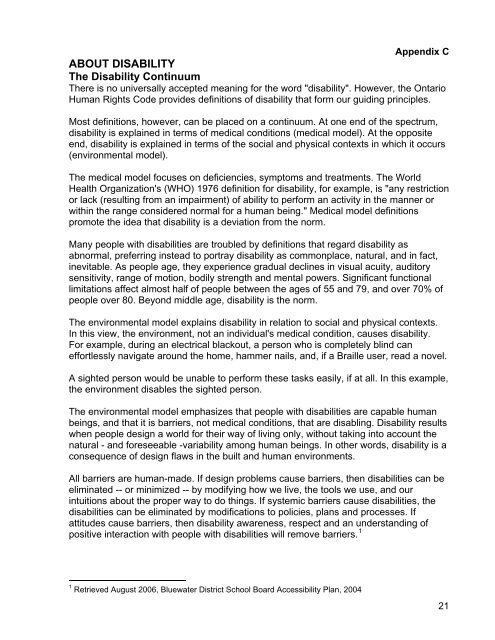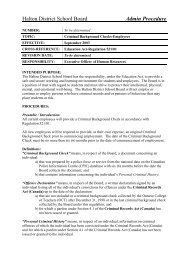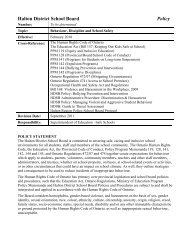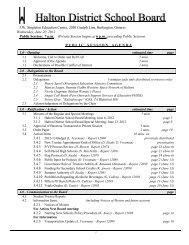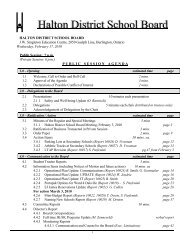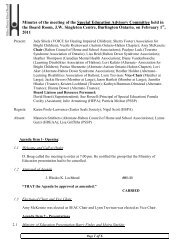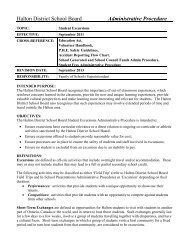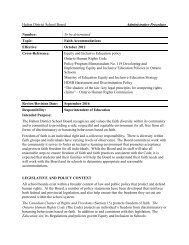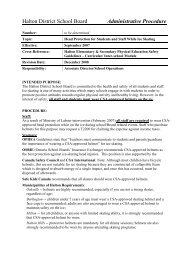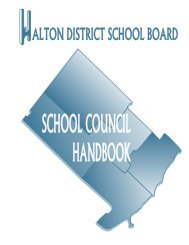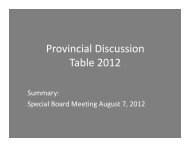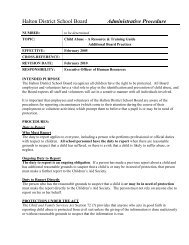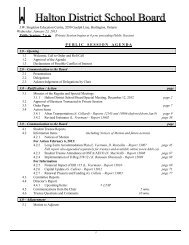2006-2007 Accessibility Plan - Halton District School Board
2006-2007 Accessibility Plan - Halton District School Board
2006-2007 Accessibility Plan - Halton District School Board
Create successful ePaper yourself
Turn your PDF publications into a flip-book with our unique Google optimized e-Paper software.
Appendix C<br />
ABOUT DISABILITY<br />
The Disability Continuum<br />
There is no universally accepted meaning for the word "disability". However, the Ontario<br />
Human Rights Code provides definitions of disability that form our guiding principles.<br />
Most definitions, however, can be placed on a continuum. At one end of the spectrum,<br />
disability is explained in terms of medical conditions (medical model). At the opposite<br />
end, disability is explained in terms of the social and physical contexts in which it occurs<br />
(environmental model).<br />
The medical model focuses on deficiencies, symptoms and treatments. The World<br />
Health Organization's (WHO) 1976 definition for disability, for example, is "any restriction<br />
or lack (resulting from an impairment) of ability to perform an activity in the manner or<br />
within the range considered normal for a human being." Medical model definitions<br />
promote the idea that disability is a deviation from the norm.<br />
Many people with disabilities are troubled by definitions that regard disability as<br />
abnormal, preferring instead to portray disability as commonplace, natural, and in fact,<br />
inevitable. As people age, they experience gradual declines in visual acuity, auditory<br />
sensitivity, range of motion, bodily strength and mental powers. Significant functional<br />
limitations affect almost half of people between the ages of 55 and 79, and over 70% of<br />
people over 80. Beyond middle age, disability is the norm.<br />
The environmental model explains disability in relation to social and physical contexts.<br />
In this view, the environment, not an individual's medical condition, causes disability.<br />
For example, during an electrical blackout, a person who is completely blind can<br />
effortlessly navigate around the home, hammer nails, and, if a Braille user, read a novel.<br />
A sighted person would be unable to perform these tasks easily, if at all. In this example,<br />
the environment disables the sighted person.<br />
The environmental model emphasizes that people with disabilities are capable human<br />
beings, and that it is barriers, not medical conditions, that are disabling. Disability results<br />
when people design a world for their way of living only, without taking into account the<br />
natural - and foreseeable -variability among human beings. In other words, disability is a<br />
consequence of design flaws in the built and human environments.<br />
All barriers are human-made. If design problems cause barriers, then disabilities can be<br />
eliminated -- or minimized -- by modifying how we live, the tools we use, and our<br />
intuitions about the proper way to do things. If systemic barriers cause disabilities, the<br />
disabilities can be eliminated by modifications to policies, plans and processes. If<br />
attitudes cause barriers, then disability awareness, respect and an understanding of<br />
positive interaction with people with disabilities will remove barriers. 1<br />
1 Retrieved August <strong>2006</strong>, Bluewater <strong>District</strong> <strong>School</strong> <strong>Board</strong> <strong>Accessibility</strong> <strong>Plan</strong>, 2004<br />
21


